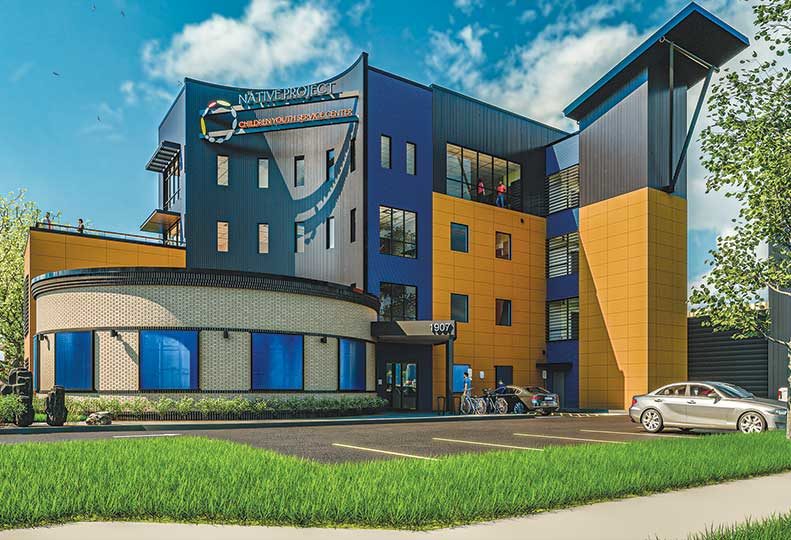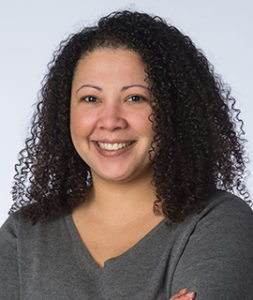
The Native Project expands plans for West Central youth center
Despite higher price tag, $11.6M development is nearly fully funded

Foundation work started on The Native Project's new youth center last August, and the facility is scheduled to be completed by year's end.
| Womer & AssociatesConstruction plans for The Native Project's new youth center have expanded since the project was first announced last year, raising the cost estimate for the building to $11.6 million, says Toni Lodge, CEO of the Spokane-based social service nonprofit.
Updated plans for the youth center call for a four-story, 15,000-square-foot building that will free up room to provide wellness, behavioral, and medical services at its existing health care clinic, says Lodge, a Turtle Mountain Chippewa member.
"This is for the BIPOC kids of Spokane," says Lodge, referring to children of the Black, Indigenous, and people of color communities in the city. "(The youth center) is not just therapeutic. It's not just counseling, but it's culture, and it's activities, and it's prevention programs."
The site for the planned youth center is located at 1907 W. Maxwell, west of The Native Project's 35-year-old, 20,900-square-foot health clinic at 1803 W. Maxwell, in west central Spokane.
Foundation work for the youth center started last August, and construction is expected to be completed in December.
Halme Cascade General Contracting Co., of Medical Lake, has been selected as the general contractor, and Womer & Associates Inc., a Spokane-based, Native American-owned architectural and engineering company, designed the project.
Weneha Group Inc., a project management and construction company based in Federal Way, Washington, is providing construction administration services.
"We have two Native-owned businesses we've contracted with (that are) contributing to the $11 million investment in West Central," says Lodge, referring to Womer & Associates and Wenaha Group. "That's a big deal."
The expanded youth building is 2,300 square feet larger than preliminary construction plans called for.
Behavioral, cultural, and healing services and activities will be provided in both open group settings and private meeting rooms in the new building, says Lodge.
Chief operating officer Maureen Rosette, a Rocky Boy Chippewa member, says each floor of the youth center will provide services based on age.
"Each floor represents what we teach kids throughout their time at The Native Project," says Rosette. The first floor is the turtle level for the youngest, followed by salmon on the second floor, bears on the third floor, and eagles on the fourth floor.
She adds, "It represents what we teach them in our leadership (program): to become warriors, nurturers, scholars, and community activists. Those four levels are representative of the vibrance of medicine—the physical, mental, emotional, and spiritual."
A circular room lined with large windows dubbed the Cullooyah Cultural Circle after Kalispel Tribal Elder Francis Cullooyah will dominate the front of the youth center. The space will be used for a variety of purposes, including ceremonies, healing circles, art activities, and prevention programs, says Lodge.
Even though the larger structure comes with a higher price tag, Lodge says the project is nearly fully funded.
"It's the dream of a lifetime to be able to open this without, hopefully, any debt," she explains.
Funding sources include a $5.7 million grant from Indian Health Service, $1.4 million from the Washington state Department of Commerce, $570,000 from Seattle-based Inatai Foundation, $535,000 from the federal Health Resources and Services Administration, $300,000 each from Spokane-based Empire Health Foundation and Spokane County, and over $830,000 from the state's share of American Rescue Plan funding.
The Native Project also has dedicated $1 million from the organization's savings and reserves for the youth center, says Lodge.
A $1 million grant is expected to complete project financing and likely will be announced in the coming weeks, pending grant approval, she says.
Opening the youth center debt-free, "means we can put our money into programs instead of infrastructure, and we can invest in the best equipment for our youth," says Lodge.
Plans for the youth center were prompted by a growing population of urban youth and community feedback.
"A third of our population is under 18, and so a third of all our programming needs to be for people under 18," Lodge explains.
In early January, The Native Project purchased a half-acre lot behind the current clinic for $675,000, tax information on file with Spokane County shows. That lot previously had been used for commercial storage.
The warehouse will be razed and replaced with a parking structure for The Native Project's employees, leaving the existing parking available for campus visitors, says Lodge.
The Native Project's ultimate goal is to create an integrated care campus for the West Central neighborhood, that could serve as a model for other neighborhoods in Spokane County, says Lodge.
"We can do this, but we have to invest in it," she says. "Every middle school and high school should be able to make a referral to a place like this in their area."



_web.jpg?1732178234)
